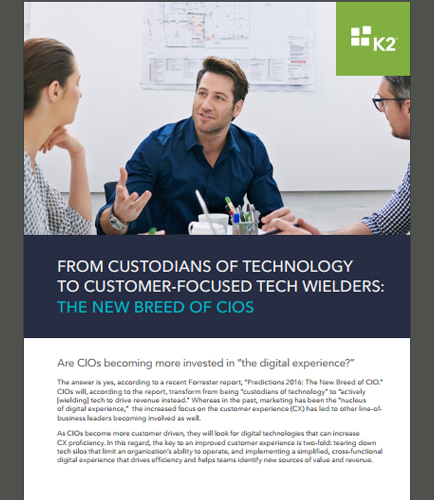
PROCESSING. PLEASE WAIT...


White Paper: K2
Are CIOs becoming more invested in “the digital experience?” What kind of digital transformation strategy is needed to drive this experience?
To drive digital transformation and growth, CIOs should be digitally savvy and obsessed with CX proficiency. In the future, they might face challenges stemming from more sophisticated business demands, and it's important to respond to those with agility, efficiency and organization.
Painting the big picture while driving new revenue and delivering a quick ROI
Simplifying and optimizing business productivity
Business Apps: Where agility meets digital transformation
Cyber security: Top concerns for CIOs
Agile: The new norm
Download this whitepaper and find out how flexible business transformation platform can improve customer-facing processes and accelerate revenue.
By: BPM-D
Value‐driven Business Process Management Discipline directs the traditional process improvement approaches like Lean or Six Sigma to the right targets where they deliver best value and address issues through other approaches with an appropriate automation. But the traditional process improvement approaches often don't lead to any tangible business outcomes while consuming significant resources. To ensure the long‐term success of such business process improvement initiatives, you need to understand: What processes have a high impact on your business strategy? What are the additional capabilities and processes that a company with traditional improvement approaches would require to build a value-driven Business Process Management discipline? What processes are less critical for achieving organization's strategic objectives? What is the sole purpose of your business process improvement strategies? This whitepaper looks at how organizations can use the Business Process Management Discipline to overcome many of the shortcomings of traditional process improvement approaches and point them at the right targets where they deliver best value. Inside this Business Process Management whitepaper: Key characteristics of traditional process improvement approaches Importance of Separation between business and IT process improvement initiatives Solving significant issues related to analyzing and improving business processes Identifying Process management capability gaps Business process mapping, modeling & analysis
By: BPM-D
Why has standardization and harmonization in Business Process Management become so much more important in this digital world? Measuring success of standardization and harmonization initiatives has a dramatic impact on BPM enablers. But complex market conditions combined with digitally empowered consumers present a challenging commercial environment. So, how can you achieve this? When processes are aligned and good practices are applied, efficiencies are created, freeing people to innovate. In order to achieve this alignment and efficiency, standardization and harmonization of business processes is important. This whitepaper guides you on all five of these critical areas in the context of standardization and harmonization and actions to be taken to improve standardization and harmonization in business processes. What’s inside this whitepaper? What are the business process standardization and harmonization in BPM? Standardization of processes benefits. The Process Implementation Challenge. Adopting Standard Business Processes – Fast at low risk. Process Governance, Process Knowledge Management, People Engagement.


 2026 All Rights Reserved | by: www.ciowhitepapersreview.com
2026 All Rights Reserved | by: www.ciowhitepapersreview.com